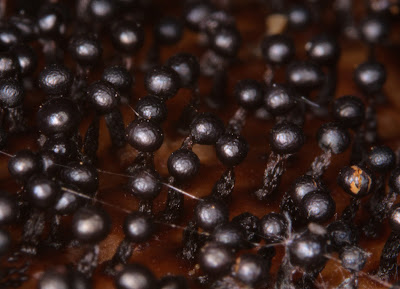 |
| Trichia Sp. Probably decipiens |
Having collected a few of the sporangia, I carried on up the track to where I knew there was a bit of a damp dingle, where I could search for more slime moulds and soon after entering it, I found my first sporangia. This again may be T decipiens, so I collected another specimen.
 |
| Trichia Sp; possibly decipiens |
On the same log as the above Trichia, were several of these grey cup fungi, with conspicuously hairy outsides and rim. This may be Glazed Cup (Humaria hemisphaerica), but you guessed it; I will have to collect a cup, to examine microscopically and test with Melzer's reagent.
Note: I have since collected one (this one, actually) and spent part of today's wet morning peering down the microscope at it. The asci didn't blue with Melzer's and were within the right size range, The hairs were septate, awl shaped and all the right size, while the ascospores were broadly ellipsoid, coarsely warted, had two conspicuous oil bodies and were all within the given size range, so the conclusion is that it is hemisphaerica.
 |
| Confirmed Humaria hemisphaerica |
The weather conditions were a little dry for slime mould hunting, but having walked past a log on the ground, I did a double take and went back to it, confirming that I had been right and it was indeed covered in tiny, glossy black beads. It was definitely a slime mould and probably a Trichia, but not decipiens. Laying on my stomach in the damp leaf mould and brambles, I took lots of photos and as some of the sporangia were splitting open to reveal their load of orange spores, I took a specimen or two. I am almost certain that it is Trichia botrytis.
 |
| The sporangia were crowded in places |
 |
| Elderberries, anyone? |
 |
| Splitting open to reveal spores |
On Sunday; wanting to get more shots of the Trichia botrytis, I went back there in the rain and after getting my photos, I went back to the log with the white jelly, only to find it gone: well sort of. In place of the white jelly, I was delighted to find the unmistakable sporangia of one of the Stemonitis species of slime moulds; looking like organ pipes on stalks. In the twenty or so hours since my first visit they had transformed from the beautiful white jelly into the dark brown mature sporangia.
 |
| Hard to believe that the pristine white jelly above, turns into this in such a short time. |
At home, I found that yet again the only way to tell them apart for sure is to examine the spores, so I went back there again today, before work, to collect a specimen. Meanwhile, I came across this Russian wildlife site, which is all in Russian (who'd have guessed?), but with some amazing time lapse sequences of a Stemonitis doing its stuff (you have to scroll down a bit to find them)
http://spacenoology.agro.name/?page_id=4349






Excellent photo's, partic' the Stemonitis.
ReplyDelete